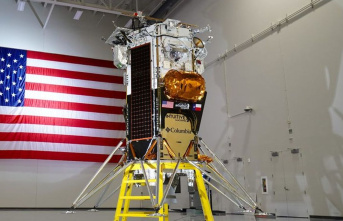The double champion of the universe! The quasar, designated J0529-4351, is the brightest object astronomers have found to date - 500 trillion times as bright as our Sun. The gigantic object is said to already contain around 17 billion solar masses - and it is constantly getting heavier, thanks to a black hole at its center. This in turn, a second record, appears to be the most voracious and fastest growing of its kind. Every day its mass increases by that of another sun, scientists report in the journal Nature Astronomy.
Quasars get their name because they are “quasi-stellar” objects – you could also say: quasi-stars. But where a real star appears as a hot, glowing ball of gas like the sun, the quasar can be imagined more as a kind of wildly swirling light donut - with a black hole in the middle. The bright "accretion disk" consists of gas or solid matter that was attracted to the black hole and is now rotating in a destructive vortex. A lot of frictional energy is created within this disk and is radiated. This is why quasars appear so bright. They typically form the huge hot center of a galaxy.
To study quasars, astronomers use a wide range of instruments: Ground-based telescopes that collect visible light, infrared or radio waves make it possible to see quasars as they looked hundreds of millions or even a few billion years ago. The quasar in the galaxy "Markarian 231" is the closest quasar to Earth discovered to date. Since it is around 581 million light-years away from Earth, the images of it show its shape more than half a billion years ago. Telescopes can even split the radiation from quasars according to wavelengths and thus reveal their composition, temperature and dynamics using this so-called spectroscopy.
Flying observatories such as the Hubble and James Webb Space Telescopes have the most precise view because they are not hindered by the Earth's atmosphere: the Earth's gas envelope can obscure or block certain types of light. Even clearer images in the ultraviolet, X-ray and infrared spectrum can therefore be captured from orbit. The combination of ground-based and space-based instruments makes it possible to study quasars across the entire electromagnetic spectrum. This overall picture provides insights into the “nursery” of the universe, information about the properties of black holes and the evolution of galaxies.
Because it was incorrectly classified as a normal and not even particularly distant star. The discovery of the brightest quasar in space is like a crime thriller: The luminous object J0529-4351 was identified in 1980 in images from the Schmidt Southern Sky Survey of the European Southern Observatory (ESO). In order to find the very rare quasars, such large areas of the sky are observed and measured that huge amounts of data are generated. These can almost only be evaluated with the help of artificial intelligence, i.e. learning software.
But sometimes these models are overwhelmed when a celestial object appears that is so large, bright or unusual that the system cannot compare it to anything else - as was the case with the giant quasar J0529-4351. It was classified by computer analysis as too bright to be a quasar and instead classified as an ordinary and relatively close star. It was only recognized as a quasar in 2023 with the help of the Siding Spring Observatory in Australia. Further radiation analyzes from the European Southern Observatory's (ESO) Very Large Telescope (VLT) in Chile's Atacama Desert have now provided crucial data that it is the brightest object in the entire universe.
Quasars are among the rare objects in space - but astronomers have already discovered and cataloged more than a million quasars using modern methods. However, it is not yet possible to estimate how many of these special types of black holes there actually are in the universe.












